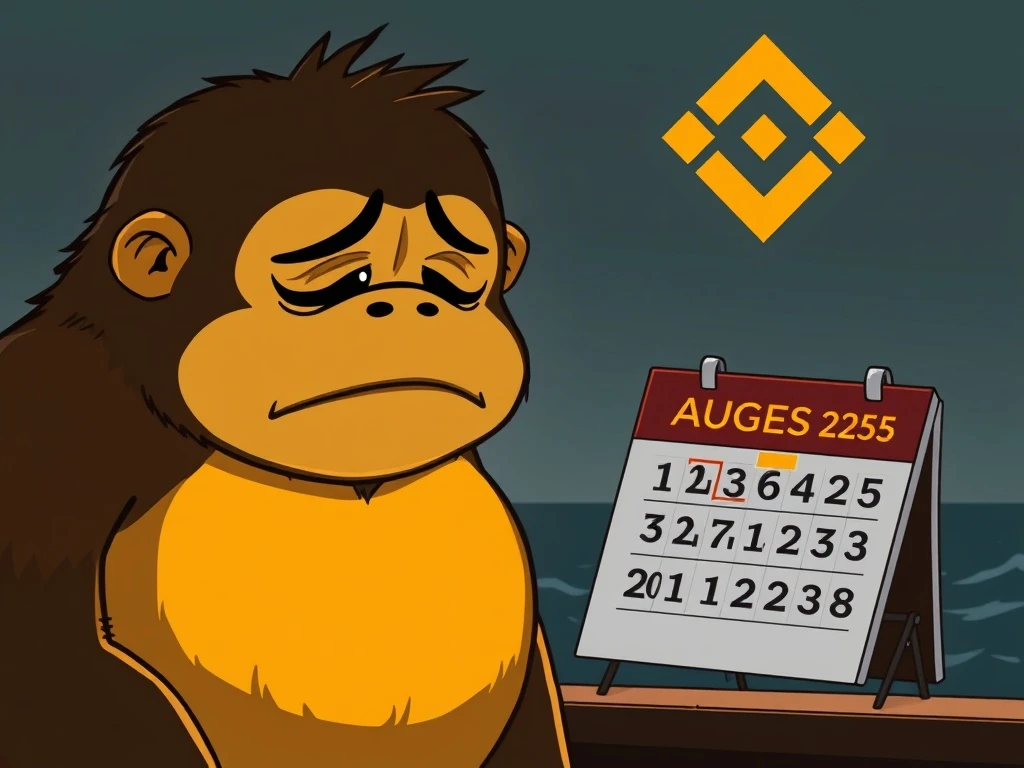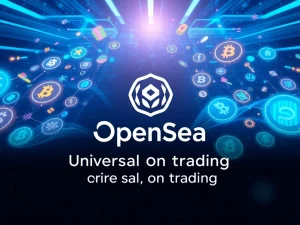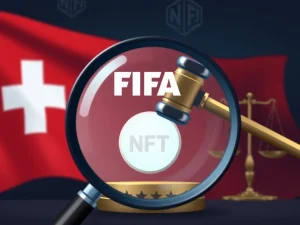Binance NFT Staking: A Crucial Shift as BAYC & MAYC Rewards End by 2025

Big news has just dropped from one of the crypto world’s giants, and it’s set to reshape how many interact with their prized digital assets. Binance NFT has officially announced the discontinuation of Binance NFT Staking rewards for Bored Ape Yacht Club (BAYC) and Mutant Ape Yacht Club (MAYC) NFTs. This pivotal change is slated for completion by August 2025, marking a significant recalibration in the NFT landscape.
For thousands of NFT holders, this means a shift in strategy. All staked BAYC and MAYC NFTs will be automatically unstaked and returned to user accounts by August 3, 2025. After this date, these iconic NFTs will no longer generate passive income on the platform. This move isn’t just a platform-specific tweak; it signals broader industry trends and evolving priorities for major exchanges like Binance.
Why is Binance Adjusting its APE Protocol and Staking Offerings?
The primary driver behind Binance’s decision is cited as adjustments to the APE Protocol‘s NFT staking mechanism. The crypto industry is dynamic, and exchanges frequently revise their staking programs in response to underlying protocol updates or changing market demands. Binance’s official statement underscores this adaptation, indicating a strategic recalibration.
While specific future offerings weren’t detailed, this decision suggests a strategic pivot towards NFT projects that exhibit stronger long-term viability or higher demand, moving away from reliance solely on tokenomics-driven incentives. It reflects a maturing market where utility and sustainable value are increasingly prioritized over speculative gains.
The Impact on BAYC Staking and APE Token Holders
This discontinuation directly impacts approximately 10,000 users who have been holding and staking their BAYC and MAYC NFTs since their launch in 2021. These collections, created by Yuga Labs, were pioneers in introducing staking as a revenue stream for holders, and Binance’s support since 2022 significantly boosted their adoption.
The market reaction to this announcement has been relatively muted for the NFTs themselves, with public discourse focusing mostly on logistical questions about the unstaking process. However, the APE token, which underpins the BAYC and MAYC staking ecosystem, has seen a notable decline in value. As of July 25, 2025, APE trades at $0.64, experiencing a 34.57% drop in its market capitalization year-to-date. Analysts suggest that reduced staking activity could further dampen demand for APE, as its utility is closely tied to the incentives provided by platforms like Binance.
This development prompts a critical question for holders: where do we go from here? The shift away from centralized BAYC Staking options could encourage a move towards self-custody practices or exploration of alternative decentralized finance (DeFi) avenues, though this remains to be seen on a large scale.
What Does This Mean for NFT Rewards and the Broader Market?
Binance’s decision highlights a significant trend in the evolving NFT sector. While NFT Rewards have traditionally been a key incentive for holding and retaining digital assets, their diminishing role on major centralized platforms like Binance reflects a broader industry shift. The focus is moving towards use cases that align more closely with blockchain’s foundational value propositions, such as:
- Governance Rights: Empowering holders with voting power in decentralized autonomous organizations (DAOs).
- Metaverse Access: Providing exclusive entry or benefits within virtual worlds.
- Tokenized Real-World Assets (RWAs): Representing tangible assets on the blockchain, offering new forms of utility.
This recalibration positions Binance to concentrate on NFT projects with sustainable utility rather than those primarily reliant on tokenomics-driven incentives. It underscores the maturation of the NFT market, where platforms are increasingly prioritizing quality and functional applications over sheer quantity of supported collections.
Navigating the Future: Actionable Steps for Holders Amid Crypto Staking Updates
The timeline for this discontinuation, fully implemented by the end of 2025, provides a window for users to adapt their strategies. For those holding BAYC and MAYC NFTs, several paths are available:
- Sell Your NFTs: If passive income was the primary driver, selling before the full discontinuation might be an option, depending on market sentiment.
- Migrate to Other Platforms: Explore other decentralized or centralized platforms that may still offer staking or similar incentives for these collections, if available.
- Repurpose NFTs: Focus on other utilities offered by Yuga Labs, such as participation in the Otherside metaverse project, or explore their cultural and speculative value.
This move is part of larger Crypto Staking Updates seen across the industry, where platforms are continually refining their offerings to align with evolving regulatory landscapes and market demands. Holders must stay informed and proactive in managing their digital portfolios.
Beyond Staking: The Regulatory Context
While Binance has not explicitly linked this decision to compliance efforts, regulatory considerations likely play a role. The exchange faces ongoing scrutiny in various jurisdictions, including the U.S. and China, where evolving laws governing digital assets could influence operational choices. By streamlining its NFT services and focusing on projects with clear utility, Binance may aim to align with global compliance standards while mitigating risks associated with speculative NFT markets.
Conclusion: A New Era for NFT Utility
Binance’s discontinuation of BAYC and MAYC NFT Rewards staking marks a pivotal moment for the NFT ecosystem. It highlights a clear shift from passive income generation towards a focus on intrinsic utility and sustainable value. While early adopters of BAYC and MAYC may need to adjust their strategies, this recalibration by a major player like Binance signals a more mature and utility-driven future for digital collectibles. As the market continues to evolve, understanding these shifts will be crucial for all participants.
Frequently Asked Questions (FAQs)
Q1: Why is Binance discontinuing BAYC and MAYC NFT staking rewards?
A1: Binance is discontinuing these rewards primarily due to adjustments to the APE Protocol’s NFT staking mechanism and a strategic recalibration towards NFT projects with stronger long-term viability and utility, rather than solely relying on tokenomics-driven incentives.
Q2: When will BAYC and MAYC NFTs be unstaked from Binance?
A2: All staked BAYC and MAYC NFTs will be automatically unstaked and returned to user accounts by August 3, 2025. After this date, they will no longer generate staking rewards on the platform.
Q3: How many users are affected by this change?
A3: Approximately 10,000 users who have held and staked BAYC and MAYC NFTs since their 2021 launch are impacted by this discontinuation.
Q4: What has been the market reaction, especially for the APE token?
A4: While the NFT market reaction has been muted beyond logistical queries, the APE token, which underpins the staking ecosystem, has seen a decline in value, dropping 34.57% in market capitalization year-to-date as of July 25, 2025. Reduced staking activity could further impact its demand.
Q5: What are the recommended actions for BAYC and MAYC holders?
A5: Holders can consider selling their NFTs, migrating them to other platforms that might still offer staking or similar incentives, or repurposing them to focus on other utilities provided by Yuga Labs, such as participation in the Otherside metaverse project.
Q6: Does this decision reflect a broader trend in the NFT market?
A6: Yes, it reflects a broader industry trend where platforms are refining their NFT portfolios, prioritizing projects with clear functional applications (like governance rights or metaverse access) over those primarily reliant on tokenomics-driven passive income incentives. It signals a maturation of the NFT sector towards utility-centric assets.









